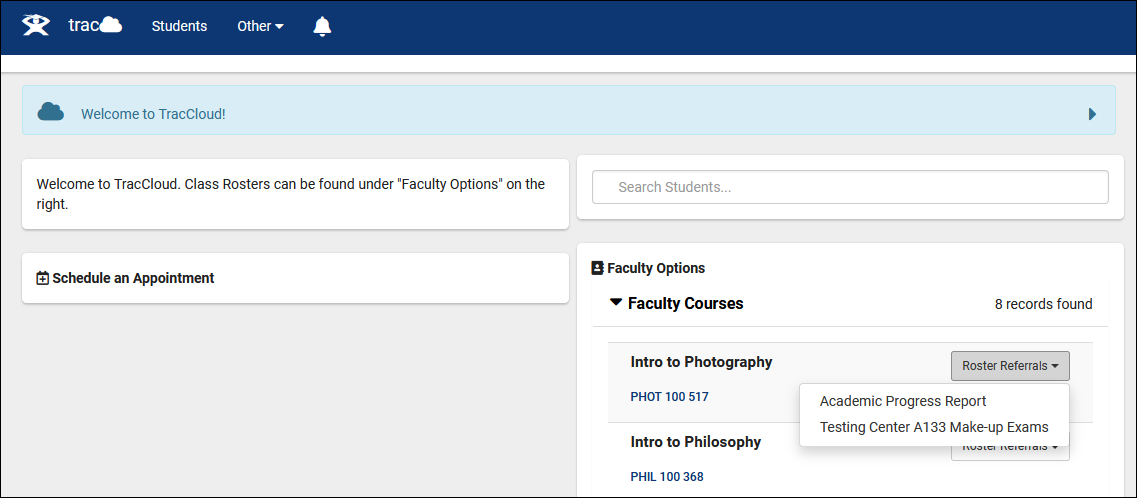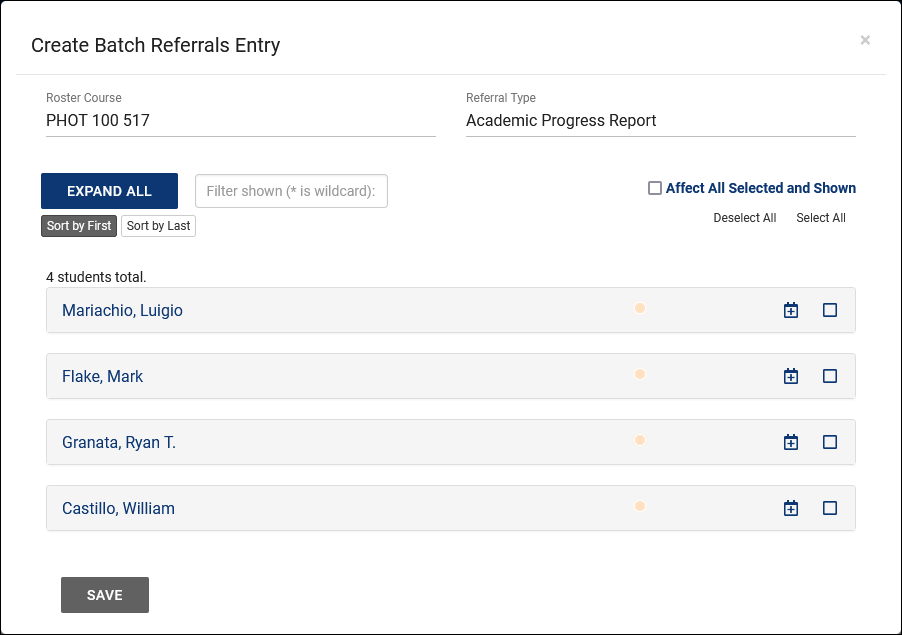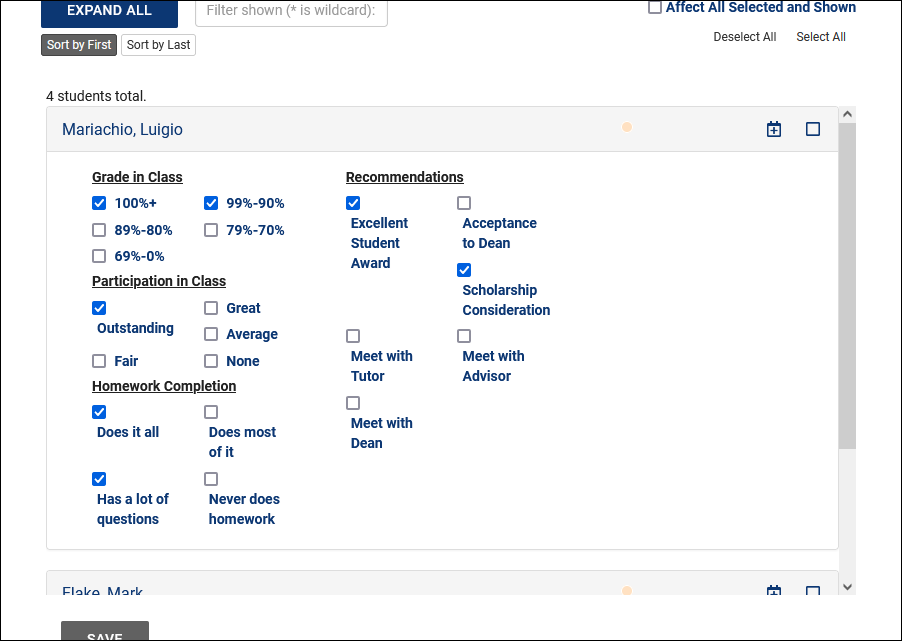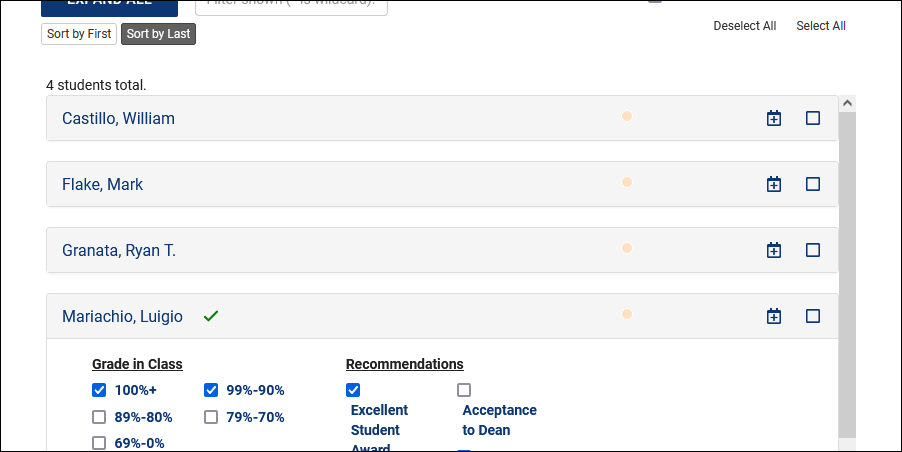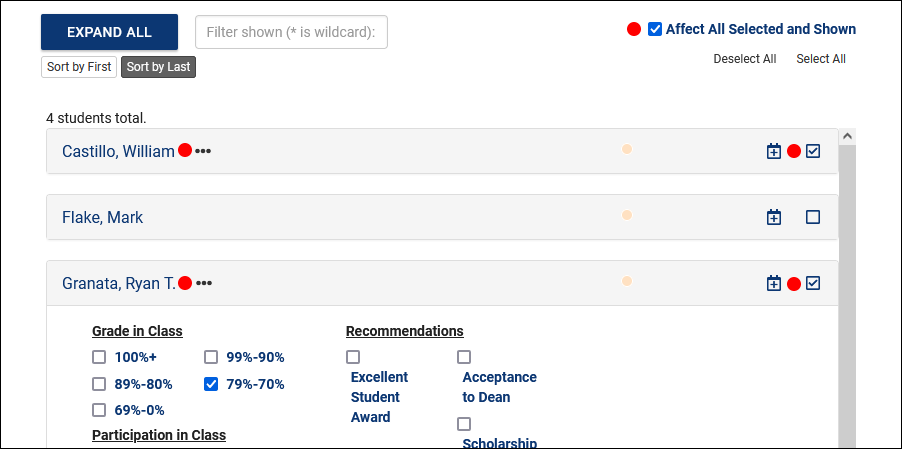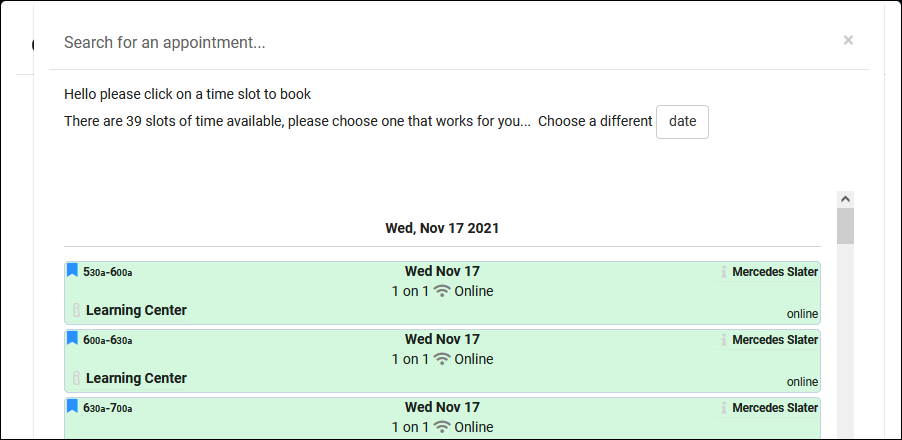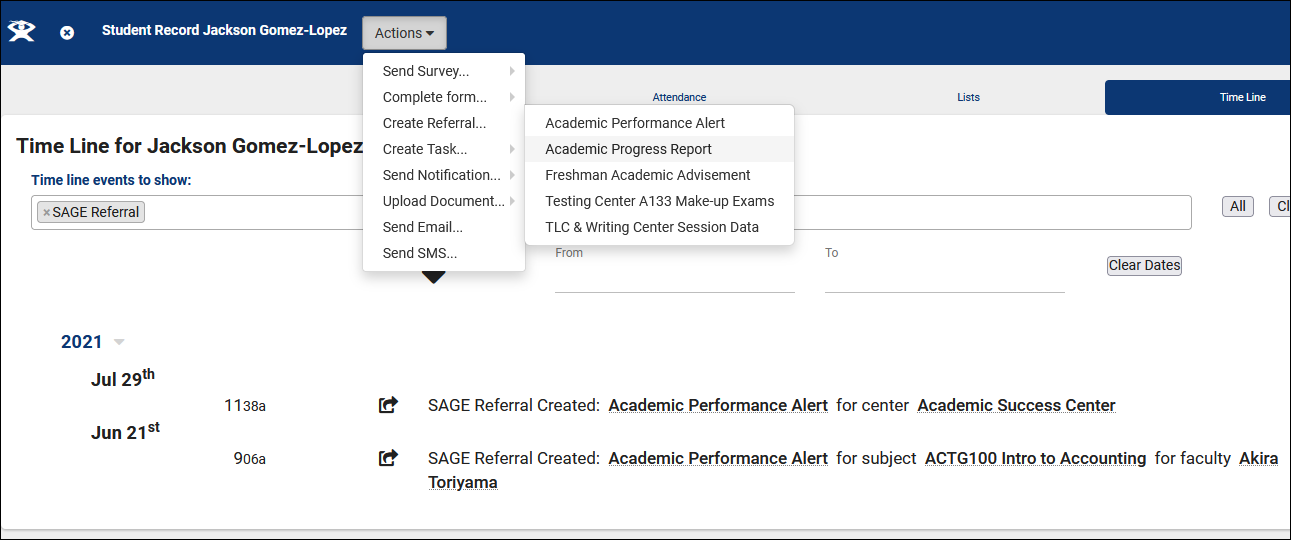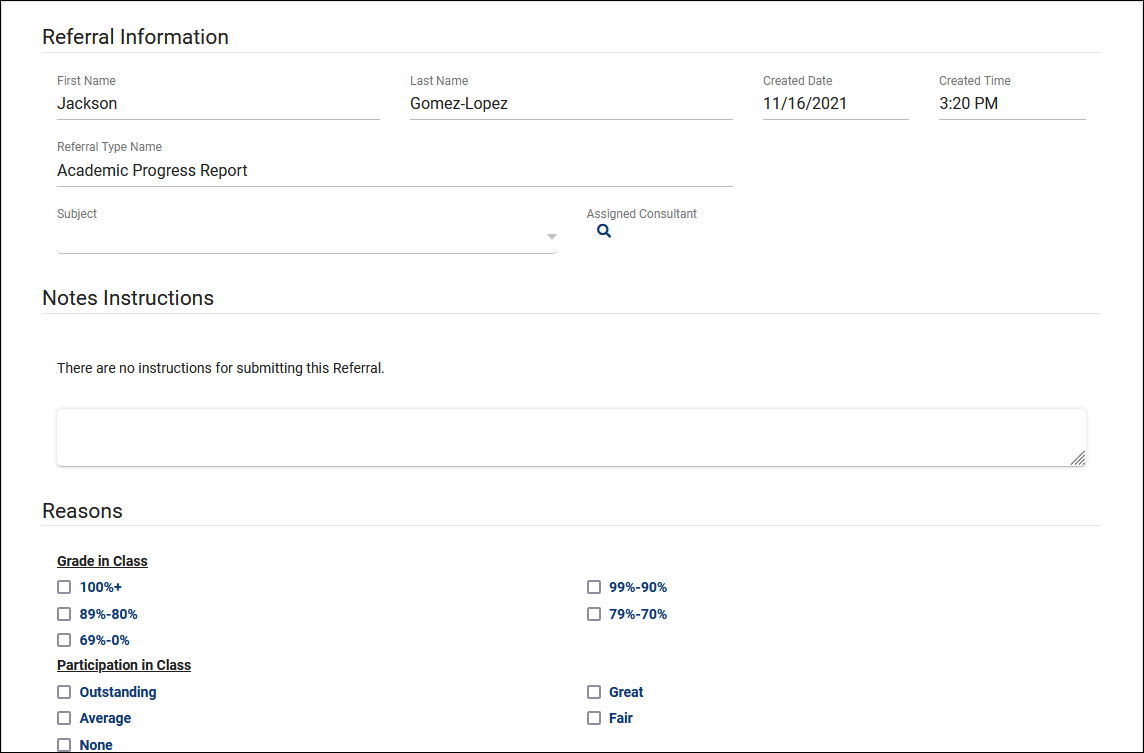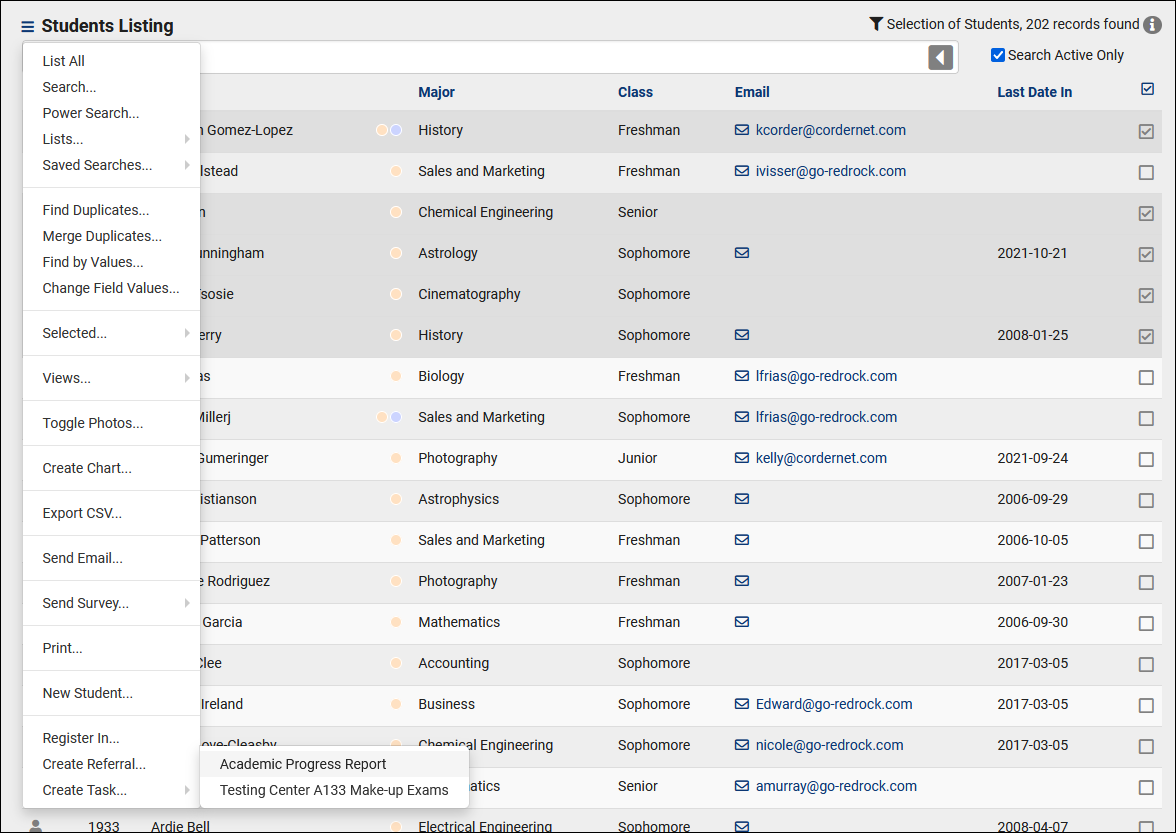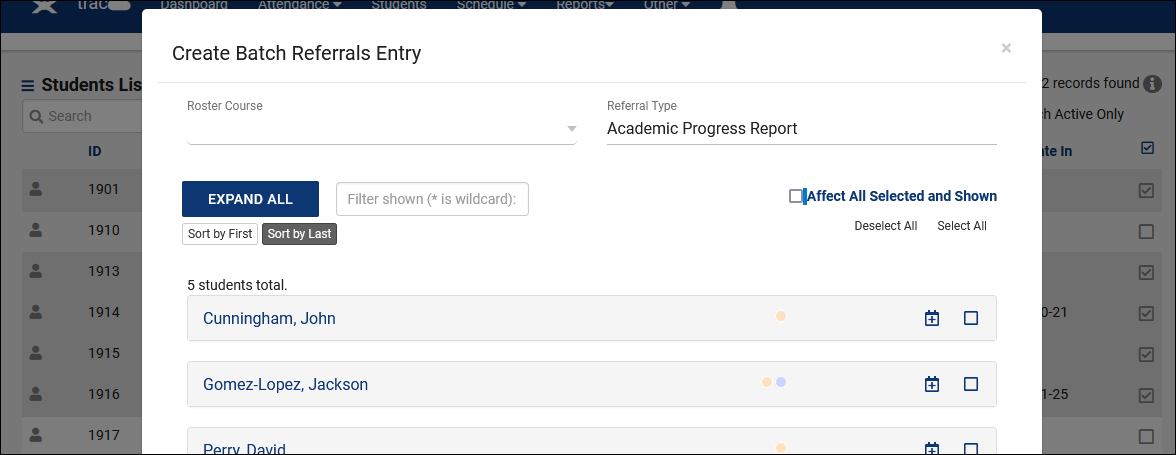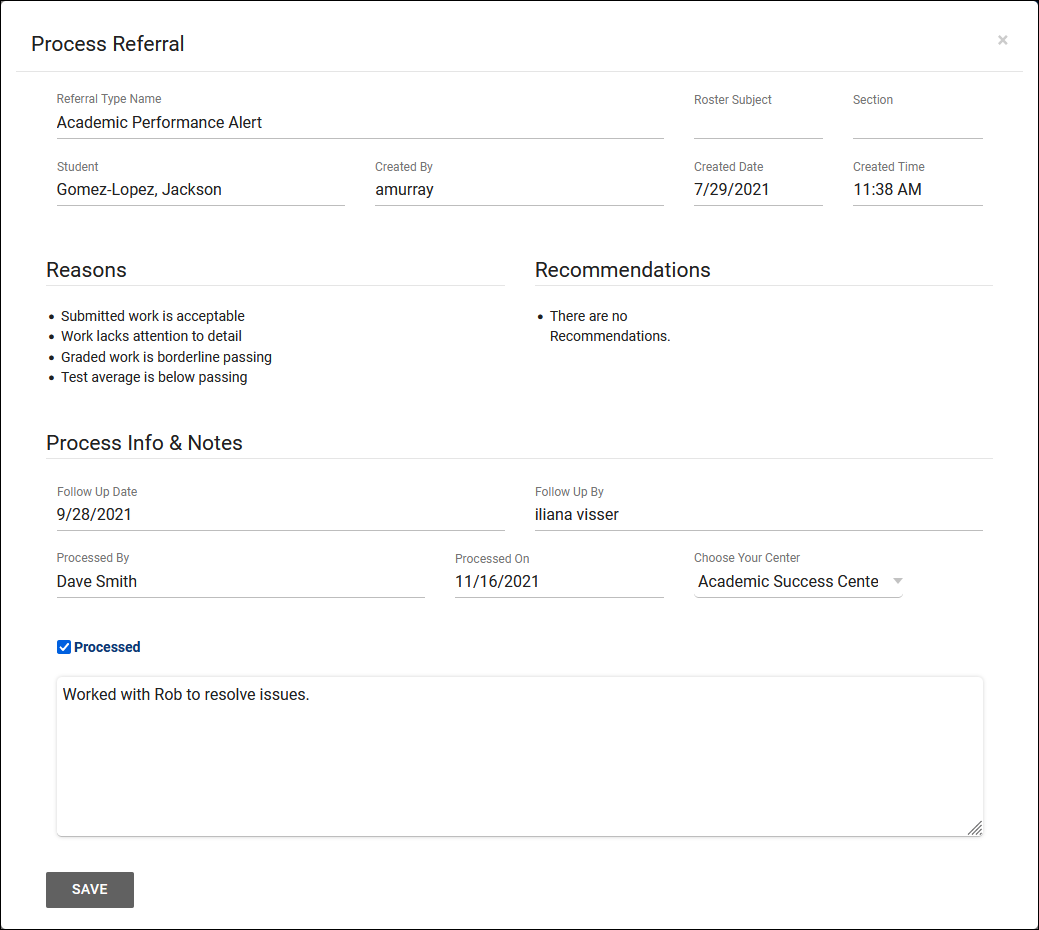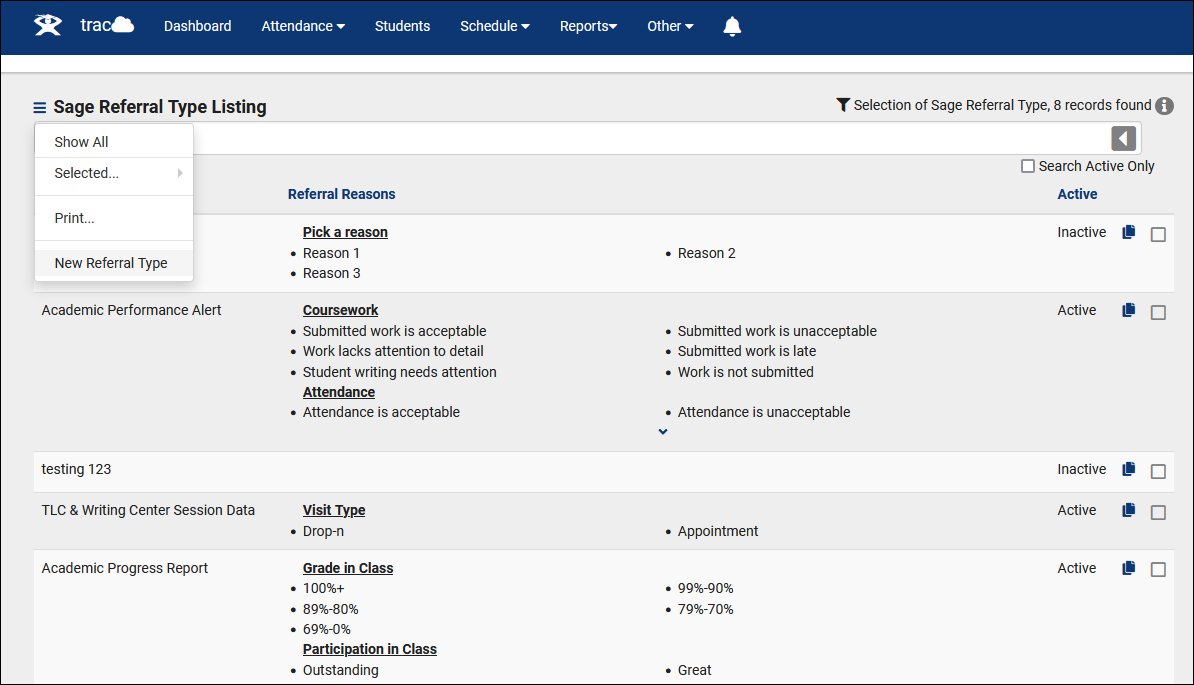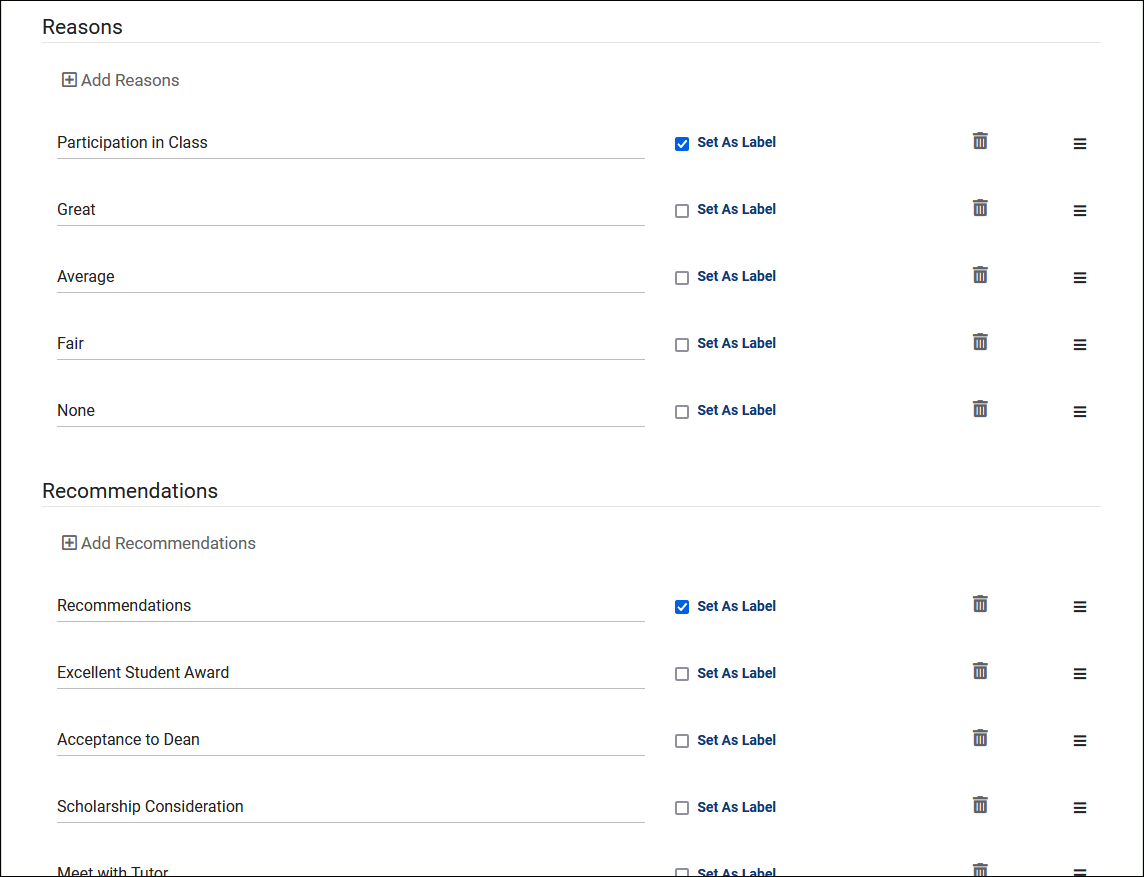TracCloud: SAGE: Difference between revisions
From Redrock Wiki
No edit summary |
No edit summary |
||
| Line 5: | Line 5: | ||
<div style='text-align: center;'> | <div style='text-align: center;'> | ||
<big><b> | <big><b> | ||
SAGE | |||
</big></b></div><br> | </big></b></div><br> | ||
SAGE (Student Alert and Group Events) is an additional module available for the Trac System. SAGE allows your faculty members to submit referrals, progress reports, or evaluations for the students enrolled in their courses. Based on the choices made while creating the referral, an automated email could be sent out to the student's assigned advisor, a professor, or otherwise, that way you and your staff can be as proactive as possible in helping your students. | |||
You can think of SAGE like a three-step process. | |||
:'''1. Creation, a referral is submitted, emails are sent out.''' | |||
:These emails could be sent to advisors, professors, or the student themselves, notifying us of something the student may be struggling with. | |||
:'''2. Follow-up, more information is given, new emails are sent out.''' | |||
:The follow-up email lets relevant users know how this referral is going, what has been done, and what we are doing to help this student. | |||
:'''3. Resolution, a final email is sent out to wrap everything up.''' | |||
:Once the referral has been processed, we can fill out some additional information letting the relevant users know what we did to help this student. | |||
__TOC__ | |||
<hr> | |||
==<b>Faculty View / Roster Annotations</b>== | |||
Faculty Members are typically the primary user-type submitting referrals, and as such, they have a streamlined view of the referral submission process. Within the faculty dashboard, you'll find their class rosters along with the referrals that have been designated as Roster Annotations (which we'll cover more later). This allows faculty to immediately access important referrals for each of their rosters. | |||
[[File:2782382.png|900px]]<br><br> | |||
As a faculty member, let's say we wanted to submit a referral for one of our classes. We can simply click on the referral we want to submit for any given roster, and we'll be given access to a batch-referral tool. | |||
[[File:8435382.png|900px]]<br><br> | |||
From this menu, we can click on individual students and fill out unique referrals for each without leaving this screen. Once we've filled out referrals for the specific students, we click save, and we're all set. The referral process has begun for each of these students that we filled out a referral for. | |||
[[File:2335678.png|900px]]<br><br> | |||
If the referral is configured as a roster annotation for [X] days (we'll cover this later), we can even open this batch-referral tool later (but within the day limit) and continue where we left off. The green check-marks indicate a referral that has already been opened. Clicking it again lets us pick up right where we left off. | |||
[[File:1308519.png|900px]]<br><br> | |||
We also have the ability to apply the same Reason/Recommendation to multiple students at once. Select <b>Affect All Selected and Shown</b> and check the checkboxes for each students we want to affect. Now when we make a recommendation or apply a reason to one student, it will also affect all other checked students. Students that have been affected by this approach will be designated by a <big><b>...</b></big> icon as seen in the image below. | |||
[[File:7205192.png|900px]]<br><br> | |||
As a faculty member, we can also book an appointment for the student from this screen as well (assuming our permission group allows it). This can be accomplished by clicking on the calendar icon on the right-hand side for the relevant student. | |||
[[File:6205497.png|900px]] | |||
<hr> | <hr> | ||
==Individual Student Referrals== | |||
Referrals can also be submitted individually from students' profiles. As non-faculty users don't have access to the class roster view, this will be their primary tool for submitting referrals, but faculty can of course use this method as well. New referrals can be created through the <b>Actions</b> button, past referrals can be viewed on the student time line. | |||
[[File:3092325.png|900px]]<br><br> | |||
After selecting the referral type that we want to submit, we're taken to the full referral submission screen. We'll cover more on configuring this side of SAGE later in this guide. | |||
[[File:8037497.png|900px]] | |||
<hr> | |||
==Student List Mass Referral Tool== | |||
We can also submit referrals from the student listing. This allows us to search for students enrolled in a specific course, pull up a list, or just search for a couple students manually and create referrals in bulk. This screen will operate in the same way as the faculty roster referral tool. Students are selected with the checkboxes on the right-side. | |||
[[File:4781587.png|900px]]<br> | |||
[[File:2946252.png|900px]] | |||
<hr> | |||
==Processed== | |||
After a referral is marked as processed, we will see the following screen summarizing basic information about this referral, and providing a location to write additional notes about how this situation was resolved. Once saved, the final "Processed" email will be sent out (which we'll learn more about later). | |||
[[File:8734417.png|900px]] | |||
<hr> | |||
==<b>Admin View and SAGE Management</b>== | |||
From an admin's perspective, we can submit referrals, create new referral types, and run reports on our SAGE data. The majority of this section will be spent going over SAGE configuration. | |||
==SAGE Configuration== | |||
To create new SAGE Referral Types, modify existing, or simply review your current configuration, go to Other > SAGE > Referral Types. This will bring you to the Referral Type Listing. To create a new Referral Type, you would click the hamburger icon ([[File:Hamburger.png|17px]]), then select <b>New Referral Type</b>. But for our Example, we're going to take a look at an existing referral. | |||
[[File:4222337.png|900px]]<br><br> | |||
Opening an existing referral type brings us to the following screen. | |||
[[File:6719490.png|900px]]<br><br> | |||
* <b>Active</b> will toggle this referral on or off, allowing you to deactivate it when unneeded, and reactivate it when necessary. | |||
* <b>Test Mode</b> sets this referral into a test mode, where all emails sent will go to the <b>Test Email Address</b>. | |||
* <b>Condense Roster Referral View</b> will display Reasons and Recommendations in a more tightly packed view for faculty. This may be preferred if many referrals are being created at once. Does not affect visible data fields. | |||
* <b>Roster Annotation</b> designates this referral type as a Roster Annotation, meaning it appears as an option for class rosters from the faculty perspective. | |||
::* <b>Days</b> is the time-frame provided to the faculty member where they can edit an existing roster referral. After this window has passed, the faculty member will create a new referral rather than editing an existing one. | |||
* <b>Linked List</b> allows you to assign this referral type to a specific student list. Faculty and other users will only be able to create this referral for students on that list. [https://wiki.go-redrock.com/index.php/TracCloudGuideGlobalLists More information on student lists]. | |||
* <b>Referral to Testing Center</b> is a bigger topic, [[click here to jump forward in this article.]] | |||
* <b>Roster Annotation Settings For Faculty Viewing</b> allows you to link this referral type to a specific subject. The referral will then only appear in contexts of that subject/course/section from the roster referral perspective. | |||
* <b>Notes Instructions</b> is a message that appears to the user submitting this referral, providing information above the Notes box. | |||
[[File:4765494.png|900px]]<br><br> | |||
* <b>Additional Notes Instructions</b> is a message that appears to the user submitting this referral, providing information above the Additional Notes box. | |||
* <b>Processed Button Title</b> determines the name of the "Processed" option, "Complete," "Resolved," etc. | |||
* <b>Hide Options</b> allows you to toggle certain elements/features of your Referral Type off if preferred. | |||
* <b>Require Notes</b> / <b>Additional Notes</b> will require that whoever is submitting this referral enter notes in one or both of these fields. | |||
<hr> | |||
==Reasons & Recommendations== | |||
Reasons and Recommendations can be one of the most important aspects in creating these referrals, as these options can also dictate which emails get sent out to whom. Typically, these would be configured to allow your faculty to quickly describe where the student is struggling and what they recommend as a solution. However, since these are entirely customizable, you can ask any questions you can think of to help make the referral creation process as straightforward as possible.<br><br> | |||
Click the <b>Add Reasons</b> / <b>Recommendations</b> box to add a new option. Setting a Reason/Recommendation as a "Label" will turn the field into a form of header for the following reasons, to help categorize your different options. These options can also be reorganized by dragging the hamburger icon ([[File:Hamburger.png|17px]]) on the right-side up/down. | |||
[[File:2280863.png|900px]]<br><br> | |||
<hr> | |||
==Custom Questions== | |||
<hr> | |||
==Potential Email Recipients== | |||
For information on purchasing the SAGE Module, reach out to [mailto:sales@go-redrock.com sales@go-redrock.com]<br> | For information on purchasing the SAGE Module, reach out to [mailto:sales@go-redrock.com sales@go-redrock.com]<br> | ||
For SAGE functionality questions, reach out to [mailto:helpdesk@go-redrock.com helpdesk@go-redrock.com] | For SAGE functionality questions, reach out to [mailto:helpdesk@go-redrock.com helpdesk@go-redrock.com] | ||
| Line 15: | Line 142: | ||
|} | |} | ||
{{DISPLAYTITLE:<span style="position: absolute; clip: rect(1px 1px 1px 1px); clip: rect(1px, 1px, 1px, 1px);">{{FULLPAGENAME}}</span>}} | {{DISPLAYTITLE:<span style="position: absolute; clip: rect(1px 1px 1px 1px); clip: rect(1px, 1px, 1px, 1px);">{{FULLPAGENAME}}</span>}} | ||
[[Category:rsc_internal]] | |||
Revision as of 23:08, 16 November 2021
Additional Features
|
SAGE SAGE (Student Alert and Group Events) is an additional module available for the Trac System. SAGE allows your faculty members to submit referrals, progress reports, or evaluations for the students enrolled in their courses. Based on the choices made while creating the referral, an automated email could be sent out to the student's assigned advisor, a professor, or otherwise, that way you and your staff can be as proactive as possible in helping your students. You can think of SAGE like a three-step process.
Faculty View / Roster AnnotationsFaculty Members are typically the primary user-type submitting referrals, and as such, they have a streamlined view of the referral submission process. Within the faculty dashboard, you'll find their class rosters along with the referrals that have been designated as Roster Annotations (which we'll cover more later). This allows faculty to immediately access important referrals for each of their rosters. As a faculty member, let's say we wanted to submit a referral for one of our classes. We can simply click on the referral we want to submit for any given roster, and we'll be given access to a batch-referral tool. From this menu, we can click on individual students and fill out unique referrals for each without leaving this screen. Once we've filled out referrals for the specific students, we click save, and we're all set. The referral process has begun for each of these students that we filled out a referral for. If the referral is configured as a roster annotation for [X] days (we'll cover this later), we can even open this batch-referral tool later (but within the day limit) and continue where we left off. The green check-marks indicate a referral that has already been opened. Clicking it again lets us pick up right where we left off. We also have the ability to apply the same Reason/Recommendation to multiple students at once. Select Affect All Selected and Shown and check the checkboxes for each students we want to affect. Now when we make a recommendation or apply a reason to one student, it will also affect all other checked students. Students that have been affected by this approach will be designated by a ... icon as seen in the image below. As a faculty member, we can also book an appointment for the student from this screen as well (assuming our permission group allows it). This can be accomplished by clicking on the calendar icon on the right-hand side for the relevant student. Individual Student ReferralsReferrals can also be submitted individually from students' profiles. As non-faculty users don't have access to the class roster view, this will be their primary tool for submitting referrals, but faculty can of course use this method as well. New referrals can be created through the Actions button, past referrals can be viewed on the student time line. After selecting the referral type that we want to submit, we're taken to the full referral submission screen. We'll cover more on configuring this side of SAGE later in this guide. Student List Mass Referral ToolWe can also submit referrals from the student listing. This allows us to search for students enrolled in a specific course, pull up a list, or just search for a couple students manually and create referrals in bulk. This screen will operate in the same way as the faculty roster referral tool. Students are selected with the checkboxes on the right-side. ProcessedAfter a referral is marked as processed, we will see the following screen summarizing basic information about this referral, and providing a location to write additional notes about how this situation was resolved. Once saved, the final "Processed" email will be sent out (which we'll learn more about later). Admin View and SAGE ManagementFrom an admin's perspective, we can submit referrals, create new referral types, and run reports on our SAGE data. The majority of this section will be spent going over SAGE configuration. SAGE ConfigurationTo create new SAGE Referral Types, modify existing, or simply review your current configuration, go to Other > SAGE > Referral Types. This will bring you to the Referral Type Listing. To create a new Referral Type, you would click the hamburger icon (File:Hamburger.png), then select New Referral Type. But for our Example, we're going to take a look at an existing referral.
Reasons & RecommendationsReasons and Recommendations can be one of the most important aspects in creating these referrals, as these options can also dictate which emails get sent out to whom. Typically, these would be configured to allow your faculty to quickly describe where the student is struggling and what they recommend as a solution. However, since these are entirely customizable, you can ask any questions you can think of to help make the referral creation process as straightforward as possible. Click the Add Reasons / Recommendations box to add a new option. Setting a Reason/Recommendation as a "Label" will turn the field into a form of header for the following reasons, to help categorize your different options. These options can also be reorganized by dragging the hamburger icon (File:Hamburger.png) on the right-side up/down. Custom QuestionsPotential Email RecipientsFor information on purchasing the SAGE Module, reach out to sales@go-redrock.com |
